|
Hawker Hurricane Mk.I
(Fabric Wing)
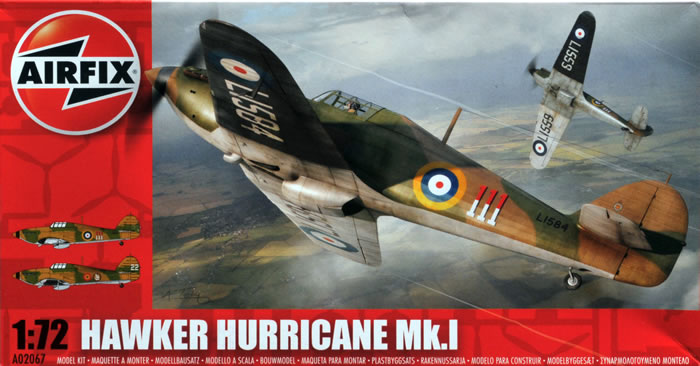
Airfix, 1/72 scale
S u m m a r y : |
Catalogue Number: |
Airfix Kit No. A02067 - Hawker Hurricane Mk.I (Fabric Wing) |
Scale: |
1/72 |
Contents & Media |
57 grey and six clear styrene parts, with decals for two colour schemes. |
Price: |
Available online from:
and numerous other stockists worldwide |
Review Type: |
First Look |
Advantages: |
Very accurate; very nice surface detail; excellent wheel-wells and undercarriage; nice cockpit; good options; nice clear parts; excellent decals; and great value too. |
Disadvantages: |
No gunsight (but maybe not strictly wrong for the markings offered); and uses a basic decal for an instrument panel. |
Conclusions: |
This is a superb effort from Airfix. I would rate it as being amongst the very best of the recent new-tool releases from this company. The kit appears to be extremely accurate in outline shape, dimensions and detail.
The surface detail is very nicely done; with the fuselage fabric areas being outstandingly good. Airfix have also done a great job of accurately portraying the layout of areas like the wheel wells and cockpit, as well as capturing the undercarriage features very well. They key features applicable to early production Hurricanes, are covered, and include the correct options as well (although no Rotol three-blade prop). The only thing that seems to be missing is a gunsight. The canopy and decals round out what is a superb kit, and all for a very competitive price.
It is obvious that this is the best fabric-wing Mk.I Hurricane in 1/72-scale so far (and I am sure the metal wing iteration will claim be the best of its type too). I now have three equal-best 1/72 kits by Airfix* - I cannot recommend this kit highly enough!
* Includes new-tool Swordfish & EE Lightning |
Reviewed by Mark Davies

Airfix's 1/72 Hurricane Mk.I Fabric Wing is available online from Squadron.com
Background
The Hawker Hurricane really needs no introduction because most aviation enthusiasts and modellers will at least know its outline history. I will therefore just mention some features applicable to the fabric-wing version that is the subject of this “First Look” review (italicized text sourced from Wikepedia):
Though faster and more advanced than the RAF's current front line biplane fighters, the Hurricane's constructional design was already outdated when introduced. It used the traditional Hawker construction techniques, with a Warren truss box-girder primary fuselage structure with high-tensile steel longerons and duralumin cross-bracing using mechanically fastened rather than welded joints. Over this, wooden formers and stringer carried the doped linen covering. Initially, the wing structure consisted of two steel spars, and was also fabric-covered. An all-metal, stressed-skin wing of duraluminium (a DERD specification similar to AA2024) was introduced in April 1939 and was used for all of the later marks. "The metal skinned wings allowed a diving speed that was 80 mph (130 km/h) higher than the fabric-covered ones. They were very different in construction but were interchangeable with the fabric-covered wings; one trials Hurricane, L1877, was even flown with a fabric-covered port wing and metal-covered starboard wing. The great advantage of the metal-covered wings over the fabric ones was that the metal ones could carry far greater stress loads without needing so much structure beneath." Several fabric-wing Hurricanes were still in service during the Battle of Britain, although a good number had had their wings replaced during servicing or after repair. Changing the wings only required three hours' work per aircraft.
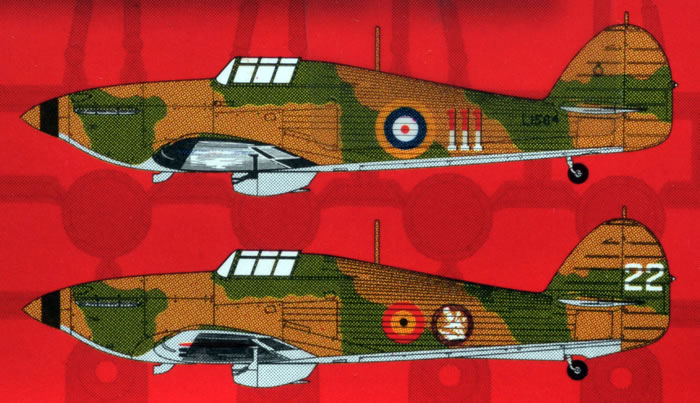
The prototype and early production Hurricanes were fitted with a Watts two-bladed fixed-pitch wooden propeller. Since this was inefficient at low airspeeds, the aircraft required a long ground run to get airborne, causing concern at Fighter Command. Trials with a De Havilland variable pitch propeller reduced the take-off run from 1,230 ft (370 m) to 750 ft (230 m). Deliveries of these began in April 1939: this was later replaced by the hydraulically operated constant-speed Rotol propeller, which came into service in time for the Battle of Britain.
The early fabric wing Hurricanes initially featured kidney-style exhausts, these being replaced by the more familiar ejector exhaust later in production, and subsequently at overhaul. Initially they also had a retractable tail-wheel (fixed permanently down after the first few months in service), and lacked the ventral strake running from mid-rear fuselage to the rudder seen on all later Hurricanes. Spin tests revealed a rudder shielding problem. Consequently, the rudder was extended by three inches and a ventral strake introduced to improve airflow over the rudder. Early models had a windscreen without braces between flat windscreen panel and the rear framing. The fabric-wing Hurricane also had a venturi mounted on the port side of the fuselage below the windscreen, and an un-tapered antenna mast.
Previous 1/72 scale Fabric-Wing Hurricane Kits & Conversions
Perhaps surprisingly, fabric-wing Hurricane kits in the One True Scale have been thin on the ground as far as I am aware. In fact, I only know of the Sword kit and a resin wing conversion by Magna Models. Both can be hard to find now. No doubt there have been other fabric wing conversions; but I was surprised to find no record of a resin kit, even by Omega, who have kitted many unusual Hurricane permutations.
The Sword kit is a good limited run edition with resin cockpit, wheel-wells and other details. It includes the necessary exhaust and ventral strake options, three propeller and three marking choices. It seems to be very accurate, matching A.L Bentley’s plans, and has extremely good surface detail. It has been out of production for some time now. The Magna Models conversion just provided a wing with somewhat exaggerated wing ribs, and was typical of the brand, being a bit rough and ready in appearance.
Without doubt then, the release of a fabric-wing Hurricane is most welcome.
Contents
The kit comes in a top-opening box with attractive artwork. The five grey sprues are enclosed in a single heat-sealed plastic bag, with the clear sprue further protected in their own smaller bag; all with acceptably attachment points. The multi-lingual instructions do not have a parts map, and have well-drawn diagrams that are easy to follow. The painting and markings guide is well done in colour with four views for each markings option. Colours are described using generic names where applicable, with paint codes that correspond to the Humbrol range.
The Kit
The first thing I think most ask about with each new Airfix release is what the surface detail is like, and how deep the panel lines are?
Well, in this case the news is good – The fuselage halves are moulded with fine recessed panel lines where applicable, probably the best I have seen form Airfix so far, and are completely acceptable. The fabric effect on the fuselage is the best I have seen for any Hurricane in this scale. In fact, it is so true to scale that brush-painters may risk losing it under several coats of paint!
An image of the real thing can be seen here.
The fabric effect on the wing and tail surfaces is quite subtle and will be acceptable to most, consisting of very gentle scalloped areas. I like it well enough, but at first was not sure it was as realistic as the treatment given to the fuselage. Take a look at this 1/32-scale fabric-wing conversion by Warbirds Productions, reviewed here on HyperScale by Brett Green in January 2006. It is apparent that the larger scale wing treatment focuses on rib tapes and taut fabric, without any real emphasis on scalloped areas between the wing-ribs. Having said this, the appearance of the example in London’s Science Museum does appear to be quite scalloped when viewed in certain lights, as indicated by these linked images here and here. On reflection I think Airfix have done a pretty good job!
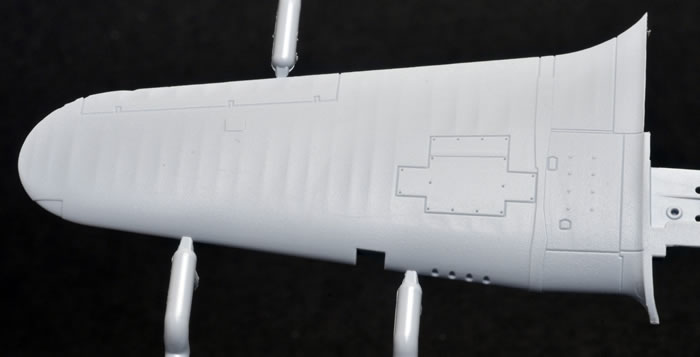
The panel lines on the wing undersides are little heavier than on the fuselage or upper-wing; but are still OK. The aileron and elevator surface detail is again scalloped. Whilst not too heavily done, this is a tad unrealistic; although so common to many kits that we almost accept it by default, and so it will be the case here I think. Control hinge-lines are well defined, with the elevator horns being particularly well done in the way they taper in behind the fixed tail surface.

Now that we have covered off the surface treatment normal review service can return. But before moving onto the cockpit, I would just like to record that surface detail seems to be an ever-improving aspect of new-tool Airfix kits; so well done Airfix. It seems that they do respond to justified criticism from their more demanding consumers.
This kit’s cockpit detail in many respects betters all previous long-run injection moulded Hurricanes in this scale. The bottom of the cockpit is provided by an area that join the two upper wing halves, onto which heel boards, rudder pedals ad control column all mount. This linking area also provides the centre roof of the wheel-well on its reverse side. Two sets of framework are provided and to which the seat fits, whilst the other incorporates the instrument panel. This last item is flat and devoid of detail, depending instead on a decal with white outlines to simulate the instruments and individual panels. How I wish Airfix would include 3-D detail on their instrument panels and use coloured decals for the instrument faces in the manner of, say, Tamiya.
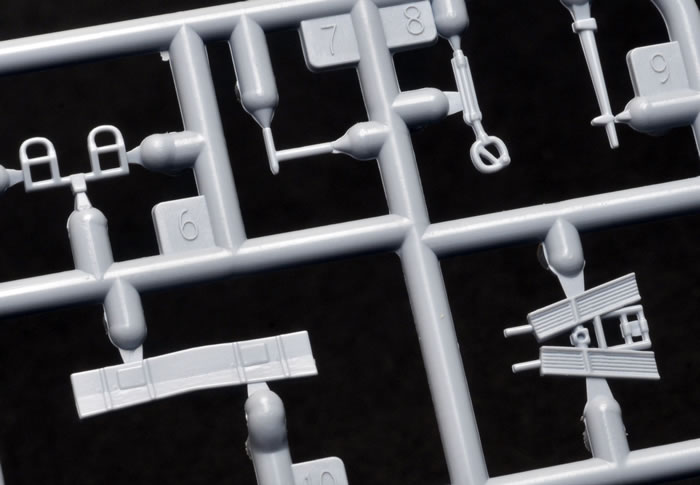
There is a choice for the rear cockpit frame that the seat fits to, one with and one without armour. The one without is applicable to the early markings options supplied with the kit. Seat armour was first fitted in spring 1940, priority going to those Hurricanes deployed to France. Armour-equipped aircraft normally had three-blade prop fitted, not only for superior performance provided by its variable pitch, but because it compensated for the weight of the armour from a centre-of-gravity standpoint. (Three-bladed aircraft without armour needed tail ballast for the same reason.) Here is how the rear cockpit bulkhead looks without seat armour; note that the Airfix part is solid behind the pilot’s head.
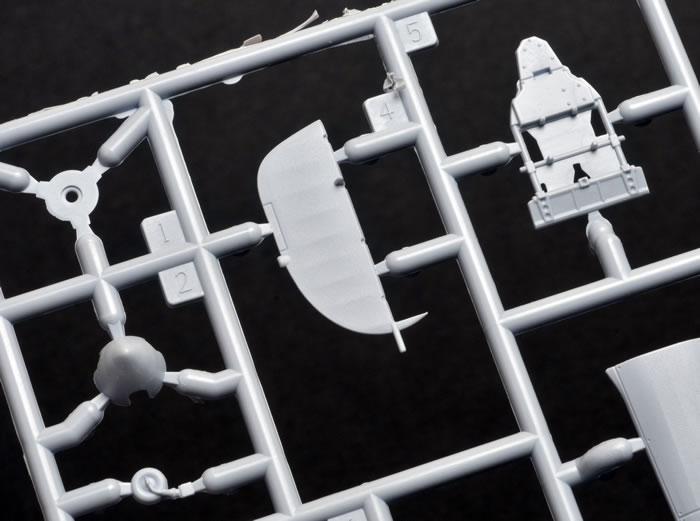
Additional cockpit detail is moulded integrally with the cockpit sidewalls. The instructions direct for a partial hole to be fully drilled out in the port fuselage, this being for the venturi to fit into later.
The cockpit will benefit from a seat harness; how about a decal for this Airfix? (Cut out with its paper backing in place to give some 3-D effect, it would suffice quite well as it does with Tamiya kits.) The other notable absence, and one that should have been included, is a reflector gunsight for the RAF machines at least. I do not know when the RAF first fitted reflector sights, but it was definitely pre-WW2. Nor do I now if the Hurricane Mk.I’s used by the Belgian or Yugoslav air forces had them. So the kit may be correct for the markings provided.
Regardless of these minor criticisms, the cockpit detail is most authentic in its layout; something that Airfix seems to be getting right with its recent new-tool kits, rather than arbitrarily resorting to using a generic floor with front and rear bulkheads as many brands do in this scale.
The wings are well engineered, and as mentioned, have two rather than three main parts because the upper surfaces are linked by the wheel-well roof. The wheel-well side of this has two injector-pin marks that will be easy to fill before assembly, but almost impossible to deal with after. Four parts must be added to the lower wing to provide the internal wheel well structure before joining the wings. These parts include the main-spar and the open frames that run front-to-rear in the centre of each well. Airfix have included the two little sight windows, that enabled the pilot to see that the undercarriage was lowered, as solid detail in the wheel-well roof. An air accumulator bottle and main coolant pipe complete this very authentic looking wheel well.
In keeping with the authentic appearance of the wheel-wells are some superbly detailed undercarriage legs with their associated retraction mechanisms (which run through the front-to-rear framework mentioned earlier). The undercarriage doors have realistic internal faceting, whilst the main-wheels are equally nice with a slightly weighted appearance moulded in. If an in-flight model is your thing, then Airfix thoughtfully included separate closed doors with wheel included, plus of course a pilot.
There is a small clear part for the signalling lamp that must be inserted in the inner side of the lower wing at its centre-rear, plus two clear parts for the wing landing-light covers. Airfix have moulded these almost solid, but with holes in their rear that give the appearance of them having a landing-light lens behind. It is not 100% accurate of course, but a lot better than either a fully solid light cover. I would still prefer thin covers with space behind to make your own lens behind them however.

Returning to the fuselage, there is a choice of rear fuselage underside, with or without the ventral strake.
Complimenting this choice are two rudders, one being the slightly deeper version to go with the strake. The tail-wheel, although simple, is well done.
The radiator housing is made of two parts that enclose separate front and rear faces for the radiator matrix. The rear of the housing has the variable hot-air exit flaps slightly drooped open, which is a nice touch. Readers may wish to add two fine actuating rods to this flap, as evidenced here, along with a small bracing rod in the front mouth of the radiator housing as seen here. There is also the carburettor air-intake to add just ahead of the radiator. Hurricane aficionados will be pleased to know that Airfix have captured the “doghouse” nicely that sits under the rear of the canopy, unlike some kits that overlook to include this feature.
Staying with the fuselage, there remains of course the tailplanes to add, along with exhaust pipes, of which there is a choice between kidney and ejector styles to suit the markings options supplied with the kit. It is likely that kidney exhausts should always go with no ventral strake; and ejectors always with the strake, whilst no doubt kidney exhausts and strake could be found together too. I really cannot say for sure. The two-blade Watts propeller is included and nicely done. Although not applicable to the markings options supplied, the kit includes a nice de Havilland three-blade prop that could be used with late-production examples as the first three-blade propos were fitted in January 1939. The kit does not include the three-blade Rotol prop which was also fitted to some fabric-wing Hurricanes (but I understand could only be matched to a Merlin III engine, unlike the de Havilland prop that could be used by with the Merlin II).
Remaining details include the correct un-tapered antenna mast, venturi for the port fuselage, and both early and later style underwing pitots. All that is left is a commendably thin and clear canopy with separate windscreen, enabling an open cockpit to be modelled. Two windscreens are provided, both are the earlier un-braced type, but one has the early external armoured glass included; although only the unarmoured type is applicable with the kit markings.
Accuracy and Buildabilty
Despite some early misfires in 1956 with their MK.IVand their Mk.I/II b of 1972, Airfix have gone on to show that they know a thing or two when it comes to Hurricanes. I have long thought their Mk.I of 1978 to be the best in 1/72-scale for overall shape, their 1973 1/24-scale MK.I was well received, and my quarter-scale mates tell me that their 1/48 Mk.I of 1979 has the best shape in that scale. I am less sure about their recent new-tool Mk.IIc under Hornby, as its general tooling put me off from obtaining one (and I think Hornby was still “finding their way” with Airfix tooling when it was produced). Anyway, I am very impressed with this latest offering.
I do not usually resort to plans, but A.L. Bentley’s do have a very good reputation, so I referred to these in my copy of Scale Models magazine from August 1980. I found that the new Airfix parts are a perfect outline match, with only about 0.25mm additional length just behind the spinner the only variation I could find. Outlines and dimensions aside, Airfix have captured the appearance of the original incredibly well; from the cockpit layout, to the wheel-wells and undercarriage, not to mention the very authentic surface detail.
I think that this kit should be very straightforward to build, certainly far more so than its only and rarely available rival by Sword, whilst representing a much better solution than using a Magna Models conversion (or for that matter converting your own as I did using an Airfix Mk.I and scratch-built wing ribs ten years ago here).
Another most welcome aspect of this kit’s release is that a later production metal-wing Mk.I is to be released as an even less-expensive Series-1 kit (I would guess with the choice of a Rotol three-blade prop to compliment the de Havilland one already featured). This is most welcome, as the only two worthwhile alternatives are the accurate but dated 1972 Airfix kit; or the 1995 Hasegawa kit with its terribly exaggerated fuselage fabric and, to me at least, an odd looking nose.
Colours & Markings
The decals by Cartograf look to be superb, as we would expect of this brand.

The two options covered are:
-
Royal Air Force – No 111 Squadron, Northolt, England (This aircraft took part in the “Fete de lair” Bastille Day celebrations, Villacoublay, France, July 1938).
-
Belgian Air Force - Squadron 2/I/2AE (Chardon), Schaffen Air Base, Diest, Belgium, May 1940.
This is a superb effort from Airfix. I would rate it as being amongst the very best of the recent new-tool releases from this company. The kit appears to be extremely accurate in outline shape, dimensions and detail.
The surface detail is very nicely done; with the fuselage fabric areas being outstandingly good. Airfix have also done a great job of accurately portraying the layout of areas like the wheel wells and cockpit, as well as capturing the undercarriage features very well. They key features applicable to early production Hurricanes, are covered, and include the correct options as well (although no Rotol three-blade prop). The only thing that seems to be missing is a gunsight. The canopy and decals round out what is a superb kit, and all for a very competitive price.
It is obvious that this is the best fabric-wing Mk.I Hurricane in 1/72-scale so far (and I am sure the metal wing iteration will claim be the best of its type too). I now have three equal-best 1/72 kits by Airfix* - I cannot recommend this kit highly enough!
* Includes new-tool Swordfish & EE Lightning
Purchased online from Hannants
Review Text
Copyright © 2014 by Mark Davies
Images Copyright © 2014 by Brett Green
Page Created 17 February, 2014
Last updated
18 February, 2014
Back to HyperScale Main Page
Back to Reviews Page

|
